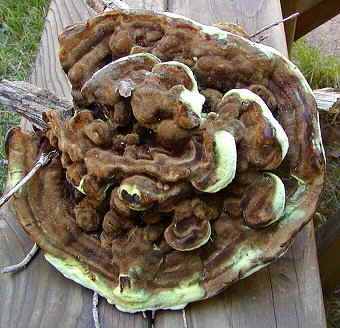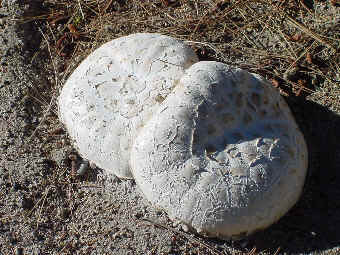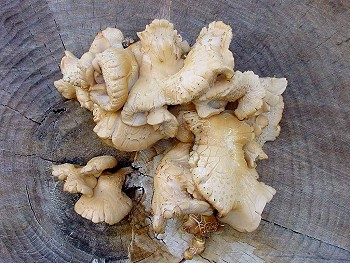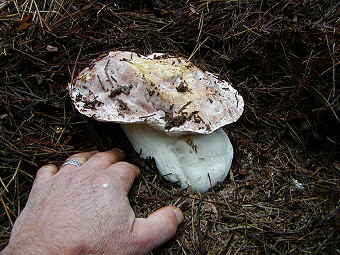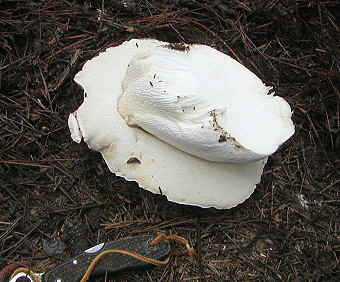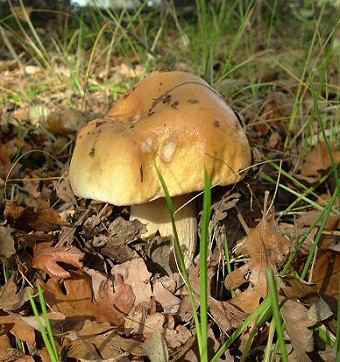|
Fifteenth Issue,
November 2004
This year was a dry one again until late fall. However, I found (or was sent pictures thereof) several new mushrooms for which I tried my best to get the IDs. In fact, I asked for ID help all the way to Pennsylvania. I solicited and received lots of gracious help from Fred Stevens, Michael Kuo, Mike Wood, Tom Volk, Debbie Viess, Jan Lundgren, Else Vellinga, John Plishke III, Dennis Desjardin, Steve Trudell, and Jim Ginns. Much of the help was requested for several of the species in the great pictures sent to me by Rebecca and Robert Geiger, who live in Banks Oregon. It apparently was a wet and good year up there in Oregon, so I decided to make a web site for their photos at www.fungi-zette.com/geigers.htm. I feel that several of the pictures are pretty spectacular. Again, this year we unfortunately weren't able to go the the Breitenbush Mushroom Festival in Oregon again, but I was able to get several pictures from the event and put together a website showing them at www.fungi-zette.com/breitenbush_2004.htm. The pictures are from Patrice Benson, Debbie Viess, and Tom Volk. Double thanks to everyone for all their contributions. Findings, July 15 to Novenber 21 (top) Thursday, July 15: Today I decided check out one of my summer boletus spots, which is above Chester at about 5100 ft. This spot is where I had been finding the Butter Bolete, the Boletus appendiculatus (correction, the B. abieticola), in previous years. Today was no exception. After scouting the area and finding a few buttons, I went back to the truck, got my collection basket, and found several in all stages of development, along with a few already emerged but fresh Yellow Coral Mushrooms, the Ramaria rasilispora. Just as I was about to leave the area, I found a small patch of either of very late Spring King Boletes, or very early Fall King Boletes. One was already pulled out of the ground and had some clean material still attached, but the rest were already too far gone. Almost all the Butter Boletes had small worms in them, but after cleaning and trimming the batch, I was still able to fill a large frying pan. This is one mushroom I serve with caution and we have a friend and a daughter who are apparently allergic to them The recent summer rainstorms sure seemed to have helped. Just in the case that the King Boletes were the early fall ones, I plan to start checking my Boletus edulis spots much sooner this year.
Tuesday, July 28: I got a phone call yesterday from a friend who lives at the other end of Indian Valley, and she told me that the giant puffballs were out again in her back yard. I immediately drove to her house, photographed them, and picked 3, the largest one being 8 inches wide by 10 inches long and weighed in at just over 4 pounds. This was the biggest puffball I have seen so far. These were a different species from those I got from the same yard last year. This time, with ID help from Fred Stevens, they turned out to be the Calbovista subsculpta, or at least two of them. The smallest in a separate batch may have actually been the Calvatia gigantia, but none were mature enough to examine under a microscope. Part of this batch will be used to make Paula Reynolds's famous Eggplant and Mushroom Lasagna. The rest I dried and ground into powder for later use. Cecelia is going to attempt to make the white sauce for this dish using some of the powdered puffballs. Might help to lower the calories a bit. Sunday, October 4: Today, Cecelia and I went up to the Bucks Lake area to see if we could find some Boletus edulis or Ganoderma oregonense.
We didn't see any edulis, but found one B. rubripes, some assorted Russulas - R. cremoricolor (?), R. brevipes var. acrior, and R. emetica, two fresh Dyers Polypores (Phaeolus sweinitzii) with which I might use to dye some white socks and tee-shirts, an unidentified soft, all cream-colored shelf mushroom which stained dark brown, and one Ganoderma oregonense. Still too dry and/or early for much other fungal growth. However, yesterday I had found one medium-sized White Chanterelle, and a smaller one two days before, at 4400 ft., in spite of the lack of fall rain. Both were under almost imperceptible bumps. I used the first one to add to a soup, which was a garlic-potato soup in which we added some Boletus edulis (cooked and frozen from last year) and some of the powdered Lentinus ponderosus from a few days ago. Yum! The larger one I gave to a friend who is pretty fond of them, and who had supplied me with the fresh spring water to help me moisturize my now pretty dry chanterelle patches. The season is still pretty early for the White Chanterelles, so I will recheck my spots in a week or so. Hopefully the added water will encourage some to make larger bumps. Wednesday, September 8: Today I went to that 4400 ft elevation to check my White Chanterelle spots, hoping that the spring water I applied 5 days ago would have made some improvements.
On the way, I picked two (of three) Lentinus ponderosus near the same stump that I had picked some in the past. When I got to my White Chanterelle spots, I found a few small, but dry, chanterelles, but none of these were found in the spots where I had dumped the spring water. Some that I had found had actually broken ground, but all were small and so dry that I had to cut off the hard edges of the small caps when I got home, and these caps were all very small compared to the size of the stalks. Because of the denseness of the flesh, I think these have been around for some time, patiently waiting for that first rain. I kind of thought that the spring water application would have fooled them into thinking it HAD rained. Maybe when I check again in a few weeks.... In the meantime, I will be trying my marinated Lentinus. Update: They didn't come out well at all! Thursday, September 16: I got a call from a friend this evening who said he found a couple very large mushrooms and wanted to bring them over to the house to show me.
I didn't ask him any questions other than where he found them. I was hoping they might be some Boletus edulis. When he got to the house, he showed me two of the largest Lentinus ponderosus that I have ever seen. Both were over 10 inches in diameter but still fresh. Because of there apparent maturity, I decided to slice them into thin strips and dehydrate them. They filled 6 large trays of my American Harvester drier. I plan to put them in the blender when they are fully dried and make a mushroom powder for adding to dishes later. Still no boletes yet! I told him what types of mushrooms I was interested in finding this time of year and also gave him a picture of a Ganoderma oregonense. I'm hoping that he will call again soon! Sunday, October 3: I just had three Boletus edulis dropped by my house today for identification. And I got to keep them too! These were just found off Indian Creek below Antelope Lake, and by their appearance, were growing in, or very close to, sand. I plant to check out the area tomorrow myself, weather permitting. I was told that it looked like it had rained a lot up that way, and was just starting to rain again before he left. I had been finding lots of Marasmius oreades (Fairy Ring Mushrooms), Agaricus campestris (Meadow Mushrooms), and Lactarius deliciosus, plus a few unidentified Suillus, but all in watered lawns around town. It is great news to hear that some edible mushrooms are finally being found in the mountains. Monday, October 4: Cecelia and I went up towards Antelope Lake this morning to see if we could find the boletus spot described by our friend yesterday, and to see if we could find more close by. We found the spot, with one large Boletus edulis still attached to a clump of five cut stumps and another wormy one tossed nearby. He had told me he had left them because they had yellow pores and some worms. I salvaged what I could from what was there, and we searched all around the area but saw only one Shaggy Mane button.
We traveled up towards the lake but found nothing in the spots that where we thought they should be. However, the ground did appear to be slightly moist in the shady areas. Then we went back down the road and found three Orange Amanitas with the white spots, in a path along the side of the creek, probably an Amanita muscaria or variety thereof. The next stop was to pick up a "Yellow mushroom" in Taylorsville that another friend had found, and it appeared to be a matured Suillus brevipes with the cap upturned. Closer to home, we found some Pisolithus tinctorius (Dead Man's Foot) along the side of the road, and then proceeded to some property above town to check out a "green, mushy mushroom", which turned out to be a bunch of five of the yellow Boletus orovillus. It was late in the day when he found them. I have only seen them once before, growing out of or near a stump. The younger ones were all yellow, and at first appearance, non-staining, but the older ones did have the reddening pores, red-streaked stems, and rapidly blue-staining flesh and pore tubes. I had planned to eat some of the orovillus because I had done so when I found the first batch, using only a small portion with no ill effects, and this time I have more to try. However, Mike Wood asked that I dry and send him the samples instead, which I did. I took several pictures of most of them, including the one above of a Meadow Mushroom, the Agaricus campestris, that I had been collecting lately. Best viewed with your browser set for full screen: amanita1.jpg Tuesday, October 4: This morning we went up towards to the Bucks Lake area to see what we might have come up after the recent rains. In short, we didn't find any edible boletes. The first stop was at a rest stop near where we had found many Boletus edulis last year, and we found some young Ganoderma oregonense (Varnished Conk). We also found a few Gomphus (Scaly Chanterelle), ranging from a small bright reddish orange one with no apparent scales, to an off-white one with plenty of scales, which I first thought might have been a White Chanterelle until I saw the scales. Then we went to the area where we had found the boletes and found more Gomphus, plus what may turn out to be the Train Wrecker, or Lentinus lepideus. We also saw a downed tree with many large and fresh Pholiotas growing out of it. We then went to a trail along the main creek that feeds into the lake and found more young Ganoderma oregonense, some Ganoderma applanatum (Artist's Conk), more Gomphus, several both old and fresh Phaeolus sweinitzii (Dyer's Polypore), several different species of conks, and what looked like a chewed off chunk of a Russula xerampelina (Shrimp Russula) on the top of an old stump. We also found an unidentified stalked polypore growing out of the top of another stump, for which I am trying to get a spore print. The ground seemed moist enough for fungal growth, except it mostly seemed pretty dry below about 8". Maybe in a few weeks, more species may start to appear as the moisture penetrates the surface. But, even without bringing home some boletes, it was a beautiful and memorable drive, viewing the bright red and yellow colors of fall. Sunday, October 24: Today was actually sunny in Greenville, so I took a leisurely ride northward to check a few of my spots up towards Lake Almanor. On the way I saw a friend who flagged me down to show me some mushrooms he had just found near the spot where we had been finding Shaggy Manes through the year. The mushrooms turned out to be some Suillus brevipes, but as we walked around the area, he found a few patches of a large, unidentified Agaricus, and a few fresh Shaggy Manes. Encouraged by this find, I searched around the area but found nothing more. I then went up towards the lake to check my Shaggy Mane spots, and at the first spot, I found them ranging in size from a small thumb to a 10-inch tall black inky umbrella. I brought back a few pounds to cook. The other spots produced nothing, but at least there was something to bring back for the table. I will keep looking! Monday, October 25: We decided to take advantage of our second sunny day and go up towards Bucks Lake to harvest the Ganoderma oregonense we had left behind after the last visit. The was little if any snow left on the ground at that elevation, and the first Ganoderma we went to pick had already been partially picked, but had grown beyond the broken portion. I picked it. In the immediate area we saw a few Pholiota aurivella and both white and orange-colored Gomphus (floccosus and bonari?), but nothing else. On the road to the next spot, we spotted a large Ganoderma oregonense on a cut stump along the side of the road. I stopped and picked it At the last spot, we found our last G. oregonense and also saw more Pholiota, Gomphus, Russula, Naematoloma fasciculare and capnoides, two large and beautiful, red Amanita muscaria, plus a few unidentified LBMs. Not much of anything in numbers except for the Naematoloma. Maybe if the sunny weather holds? I doubt it. Friday, October 29: It has been fairly clear weather for the last two days, and it looks like the previous rain has done some good in Greenville, mushroom-wise, at least in town. Today I found more of the White and Brown Field mushrooms in a local ballpark, and after the rain they now all seem to be much bigger then before. Picked a small batch. I also found lots more of the Lactarius deliciosus, minus the worms. In a church lawn close to home, I found more Marasmius oreades, and for the first time this year, some fresh Blewits! Picked both. Now if the weather just stays clear and non-freezing for a few days, maybe more mushrooms will start appearing in the wilder areas. So I plan to check my Coprinus comatus spots near Lake Almanor tomorrow, that is if it doesn't rain or snow. Friday, November 4: I received a phone call this afternoon from a friend outside town, who told me that he had seen a bunch of mushrooms growing out a downed tree and wanted to know if wanted to go see them.
We drove just outside of town, and close to the side of the road, there was several large, cut-down trees of what he told me were cottonwoods, and you could see what looked like oyster mushroom growing out the end of a large one. When we got closer to the tree, I noticed that these mushrooms had stems, but otherwise looked something like bleached-out oyster mushrooms. He then led me to the side of the tree and
showed me several clusters of what turned out to be Honey Mushrooms (Armillaria
mellea). I
picked several pounds of both, hoping that the first mushrooms might be
edible, and then checked around the immediate area and found a cluster of
the real oyster mushrooms and a few shelf mushrooms that later seem to key out to
be a Daedaleopsis confragosa (see update
for November 23 below). I picked about 3 pounds of the oyster
mushrooms and placed them
in a shopping bag. The total weight for all was over 17 pounds - 10
lbs for the first mushrooms, 4 lbs for the Honey Mushrooms, plus the 3 lbs
for the Oyster Mushrooms! I needed help getting the mushrooms over the
barbed-wire fence. After sending some of the pictures I took to Fred Stevens, he suggested that what we had found was a Hypsizygus tessulatus, a close relative to the Oyster Mushroom (Pleurotus ostreatus), and according to www.mushroomexpert.com, uncommon. I found references there for both the Hypsizygus tessulatus and H. ulmarius, but couldn't pick a close enough match for either. Update, November 23: I was finally able to get in contact with Dr. Dennis Desjardin, who confirmed that the mushrooms were the same Hypsizygus tessulatus that he had previously found in the Sierras. If you want to see more of the pictures of the Hypsizygus, go to Hypsizygus.htm. Because the polypore didn't quite fit the description in the Daedaleopsis keys that I found, I also uploaded some pictures at Daedaleopsis.htm to see if anyone had a more definite specie that came to mind. Update, November 30, 2007: With the help of Steve Trudell. I finally got the following information from his friend, Jim Ginns:
I will probably cook and taste some of the white mushrooms tomorrow. I had been too busy cooking up the others, including some rather large field mushrooms that Cecelia found in the old school yard near the house. Tuesday, November 9: I finally found some King Boletes near home today (Greenville CA).
I was told this morning that some boletes were seen just outside of town at4400 ft. I asked if they were sticky and she said no I decided to break away from my ID pursuit for the mushrooms I had found recently, first checked out my local Blewit spot, and picked a few. I then decided to check some of my edulis spots closer to town and stumbled upon a patch of what looked like light-colored Boletus aereus, the Queen Bolete. When I removed the first, it had tiny white pore tubes. Even all of them except for the oldest, had the white pores. The older ones had pale yellow pore tubes, leading me to believe I had perhaps found some of the Boletus barrowsii, the White King Bolete. I found all of them within about 30 ft. and found no additional ones in the area. I am still not sure what it is, as the color of the cap seemed too dark for a barrowsii, it had a whitish bloom like the B. aereus, the stalk seemed too reticulate for an aereus, but the white pores in the large ones really threw me. But the spore sizes were consistent with a B. aereus. The Boletus at the 4400 ft elevation turned out to be a Suillus. You can see all the pictures of the white-pored boletus at the link below to see what you think. Sunday, November 21: Today we decided to get out of the house and to go further south to perhaps a warmer area to see if we could find any mushrooms. It had been freezing at night here lately. We went to an area called Twain to a large campground there. We wandered through the whole campground, saw nothing, but just as we were getting back to the entrance, saw a few Suilluses.
At first we left them and scouted around the immediate area. We immediately found quite a few small mushrooms and I decided to take some home to try to ID them. Then we found two of the blue-green, anise-scented Clitocybe odora, var. pacifica, so I collected those. Now we saw that there were at least 3 different species of Suillus close to the road, so I took one of each. The Suillus turned out to be Suillus brevipes, S. fuscotomentosus, and S. caerulescens, the last two being the first for me in this area. I am still trying to ID the small white to reddish-brown mushrooms, but they were so cute! Guess we need to go to warmer areas now in order to look for those King Boletes. I had recently received a report of someone finding quite a few large and tall King Boletes in a park between Sacramento and Stockton. At the right is one of the pictures that Jeff Novak sent me >. The Use of Flash for Photographing Mushrooms (or not) (top) On 9/4/2004, Peter Werner posted the following on the MSSF newsgroup, in regards to photographing mushroom:
I found this reply from Mike Boom very helpful:
And this from Brad Kelley:
And also this from Ken Litchfield:
Featured Mushroom, the Oyster Mushroom, Pleurotus ostreatus (top) This year I found more than few batches of the Oyster Mushroom, the Pleurotus ostreatus, and this time most of them were pretty young and tasty. No two batches I have ever found looked the same, and the last batch I just found was a dark brown, probably from the sun. The younger ones seem to have the best taste and texture, but the larger ones are okay if tenderized like you would an abalone (or any tough) steak. We found that the larger ones, thinly sliced, are great dipped and cooked in tempura batter. They also could lend themselves as an okay substitute for clams in clam chowder, if you used your imagination. For a direct link for this mushroom on the Mykoweb site, complete with pictures, go to: |


